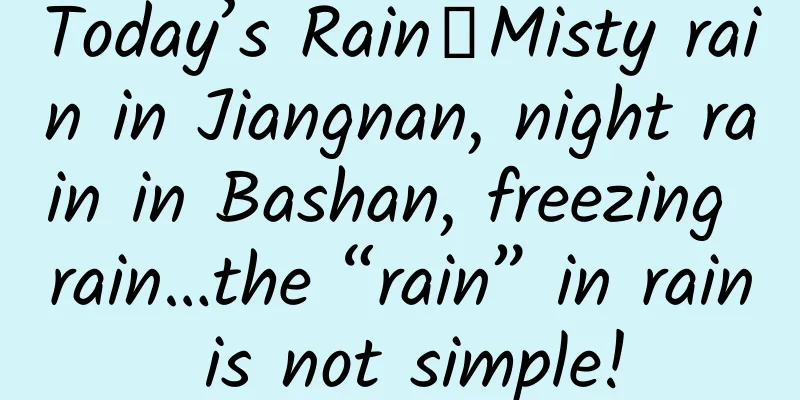Today’s Rain|Misty rain in Jiangnan, night rain in Bashan, freezing rain…the “rain” in rain is not simple!

|
As the second solar term in spring, Rain Water has two major characteristics: one is the increase in precipitation, and the other is the rise in temperature, which marks the beginning of rainfall and the increase in rainfall. Of course , increase is a relative concept , but it does not mean that it will rain when Rain Water arrives . It also depends on the specific weather system . As the temperature gradually warms up, the form of precipitation changes from snow to rain. Therefore, it is extremely appropriate to call this solar term Rain Water. Copyrighted stock images, reprinting may cause copyright disputes 01 What kind of rain is it during the Rain Water solar term? Many people think that the rain during the Rain Water solar term is called "spring rain", so what is spring rain? The term "spring rain" is a bit broad. As the name suggests, it refers to the rain that falls in spring (usually from February to May). There are differences between the north and south of China. The spring rain in the south comes earlier, in February and March, while in the north it is concentrated in April and May. In addition to rain, the solar terms associated with spring rain include the Waking of Insects and the Spring Equinox , which are the periods when spring rain occurs frequently. Spring rain gives people a very beautiful image and is even more beneficial to agriculture, so the proverb says "spring rain is as precious as oil". Spring rain is characterized by being fine, long-lasting, soft, moist, fresh, and moderate in temperature . Image source: China National Meteorological Administration There are two main reasons for the formation of spring rain: The first is the tug-of-war between cold and warm air . In spring, cold and warm air frequently meet in East Asia, and the warm and humid air in the south gradually strengthens and pushes northward, meeting with the remaining cold air to form frontal rain. The second is the monsoon transition . As the winter monsoon weakens and the summer monsoon emerges, water vapor transport conditions improve and the probability of precipitation increases. There is no such category as spring rain in the classification of rain. Frontal rain has become the main type of spring rain. In addition, there is orographic rain in local mountainous areas and sporadic convective rain . In northern China, the cold air is still active at this time, and precipitation may appear in the form of sleet or freezing rain . To sum up, the rain during the Rain Water solar term is characterized by transition, gradual increase and regional differences . 02 “Family Files” of Frontal Rain Frontal rain is the rainfall formed when the warm air rises and cools along the front when the cold and warm air masses meet. It is one of the most common precipitation types in temperate regions and is usually accompanied by changes in weather systems such as cold fronts, warm fronts or stationary fronts . In spring and autumn, when the cold and warm air masses are active, frontal rain is more common. The formation process of frontal rain is as follows: cold air and warm air meet in a certain area. Due to the high density of cold air and the low density of warm air, the warm air is forced to rise along the front. The warm air rises along the front and gradually cools down. As the warm air rises, the temperature drops, the water vapor cools and condenses into clouds. The water droplets in the clouds continue to grow and eventually fall to the ground in the form of precipitation (rain or snow). Cold front and its weather (Image source: People's Education Press High School Geography Compulsory Course 1) Warm front and its weather (Image source: People's Education Press High School Geography Compulsory Course 1) There are three types of frontal rain: cold front rain, warm front rain, and stationary front rain . (1) Cold front rain : Cold air actively advances, forcing warm air to rise rapidly. The rainfall is intense and short-lived, often accompanied by severe convective weather such as thunderstorms and strong winds. (2) Warm front rain : Warm air actively advances and slowly climbs above the cold air. The rainfall intensity is small, the duration is long, and the range is wide. (3) Stationary frontal rain : The cold and warm air masses are of equal strength, the front is stagnant, the rainfall lasts for a long time and covers a wide area, often leading to continuous rainy weather. Among the spring rains, warm front rain and stationary front rain are the most, accounting for more than 60% of the total spring rain. In comparison, cold front rain is relatively rare in spring because the strength of the cold air is weakening. 03 How many different things are there in terms of rain? Affected by latitude, topography, and the activities of cold and warm air, the precipitation distribution during the Rain Water solar term shows significant regional imbalance and climate transition characteristics, with very obvious differences between the north and the south. During the Rain Water solar term, warm and humid air currents in the south are active, and the middle and lower reaches of the Yangtze River to South China enter the early stage of the "Peach Blossom Flood", with continuous drizzle such as Jiangnan Misty Rain. Orographic rainfall is particularly significant on the windward slopes of mountains such as Wuyi Mountain and Nanling Mountains. Due to the uplift of the terrain, the Sichuan Basin and the Yunnan-Guizhou Plateau often have night rain or intermittent light rain, which is the spring version of "Night rain in Bashan Mountains swells the autumn pond". In the rainy season of 2013, tender buds sprouted from willow branches on the streets of Suzhou in the continuous spring rain. ( Photo source: Xinhua News Agency ) During the rainy season of 2016, Hainan was hit by continuous spring rain, and a morning glory was covered with crystal raindrops. ( Photo source: Xinhua News Agency ) Compared with the south, there are more areas with less rainfall in the north. Precipitation in the Yellow River Basin is mainly scattered light rain or sleet. For example, Henan and Shandong often see the transitional scene of "the snow has not yet ended, but the rain has already arrived". Most areas in Northwest China and North China are still dry and rainless. A rainy scene near Beijing Changchunjie subway station in February 2009 (Photo source: Xinhuanet) In addition, snow will be the main rainfall in the high altitude areas of the Qinghai-Tibet Plateau, and alternating rain and snow may occur in the river valleys. The ice and snow in the Northeast have not completely melted, and snow will still be the main rainfall, and "freezing rain" may occasionally occur in the Songhua River Basin. The temperature and cold and warm air are turbulent in spring. In southern China, such as Guangdong, Guangxi, and the coastal areas of Fujian, warm and humid air flows meet cold walls to form water droplets. The air humidity often reaches more than 90%, and there will be a "return of the south wind". There will also be a "late spring cold" in northern China, such as North China and the Huanghuai region. The sudden cold air may cause the green winter wheat to freeze. In southern China, such as Hunan, Jiangxi, and western Zhejiang, there may be "continuous rain". Insufficient sunshine will affect the flowering of rapeseed, and the fields are prone to moisture damage. 04 Targeted prevention guide for the Rain Water solar term The weather during the Rain Water solar term is in a transitional stage. The weather is unstable and there is a big difference in precipitation between the north and the south. Therefore, it is necessary to take corresponding precautionary measures based on regional characteristics and weather changes. (1) The southern region is rainy and humid, so attention should be paid to drainage and waterlogging prevention and moisture damage prevention. ♦ Dig ditches and clear channels in rice fields and vegetable plots to prevent waterlogging and root rot. There is a folk saying that goes, "Continuous rain means a good harvest, so don't neglect to keep the ditches clear." ♦ Cover tea gardens and orchards with straw or plastic film to reduce diseases caused by excessive soil moisture. ♦Cultivate and loosen the soil in rapeseed fields in time to promote water evaporation; spray foliar fertilizer to enhance resistance to stress. ♦Greenhouse cultivation requires enhanced ventilation, controlled humidity, and prevention of gray mold and downy mildew. (2) There is less rain and more cold weather in the northern region. We should pay attention to water storage and soil moisture conservation and prevent late spring cold snaps. ♦Use sporadic rainfall to harrow and conserve moisture and reduce soil moisture evaporation. ♦During the greening period of winter wheat, shallow hoeing should be carried out in time to cut off the capillaries to retain water, and drip irrigation should be used to replenish moisture. ♦Spray antifreeze before the cold wave arrives, or use smoke to increase temperature at night. ♦In facility agriculture, reinforce greenhouse film and cover it with straw mats or thermal blankets to prevent frost damage. (3) Countermeasures for the “return of the south wind” in the south ♦Close doors and windows tightly, use a dehumidifier or air conditioner in dehumidification mode, and control the humidity below 60%. ♦Spread old newspapers and dry towels on the floor to absorb moisture, and place bamboo charcoal bags or desiccant in the closet. ♦Turn on the TV and computer for 1-2 hours every day to use the heat to dissipate moisture. ♦Turn on exhaust fans in the kitchen and bathroom regularly to reduce water vapor retention. (4) Pay attention to anti-slip ♦In the rainy areas in the south, beware of landslides and falling rocks on mountain roads and avoid sections prone to waterlogging. ♦When driving in the rain, turn on the fog lights, keep a safe distance between cars, and avoid sudden braking. ♦Avoid traveling early in the morning during freezing rain or sleet, and slow down on bridges, ramps and other roads prone to icing. ♦Deflate non-motor vehicle tires appropriately to increase friction, and wear non-slip shoes when walking. ♦Spread snow-melting agents or sand in residential areas and courtyards to prevent rain and snow from freezing and causing slips. (5) Protect health ♦Follow the principle of “covering up in spring”, focus on protecting the neck, waist and feet, and avoid removing clothes too early. ♦Please bring an umbrella when going out in the north, and bring a thin jacket with you when going out in the south to deal with rainy and cold weather. ♦Continuous rainy weather can easily cause "spring depression". It is recommended to increase indoor exercise and appropriately supplement vitamin D. Author: Wang Yuanhong, Senior Weather and Climate Engineer, Member of the Chinese Writers Association Produced by: Science Popularization China x Xinhua Science Popularization |
<<: The sky is falling, disposable chopsticks are bleached with sulfur dioxide! ?
>>: Money is gone with a touch? Is the NFC function of mobile phones really that scary?
Recommend
Mobile phone recycling machine: valuation + recycling in just 3 minutes
A cooking robot stir-fries a plate of shrimp in 2 ...
5 major growth types of brand marketing!
First, let me say the golden sentence: Five growt...
Lao Jiang's "First-line Upgrade" advanced class's latest handicap is a new trick to achieve the secret of being one step ahead
Lao Jiang's "First-line Upgrade" Ad...
Really solve your pain points, those conscientious Android-exclusive applications: Privacy tools
The openness and freedom of the Android system ar...
The best nap time is here! Research finds that people who take naps regularly should never take naps longer than this time!
"If I don't take a nap in the afternoon,...
Douyin TopView super first advertisement is online!
"I've spent so much money, but can I rea...
Growing 40cm in 47 days! What did this "deer" eat to grow taller?
In a blink of an eye, our third-generation Sunny ...
It’s time to learn the strategies for attracting new customers in the data age!
There are two kinds of problems in this world. On...
Wake up! “Humans evolved from monkeys” is wrong!
On April 19, 1882, Charles Darwin, a British natu...
What are the functions of the insurance mini program? How much does it cost to develop a WeChat insurance mini program?
Not long ago, a colleague of mine bought another i...
Tencent Advertising Guide for the Dental Industry
1. Oral Industry Research 1. Overview of the dent...
How much is the investment price for the Hegang fast food mini program? Hegang fast food mini program investment price inquiry
How much does it cost to attract investment in th...
Why is "Chang'an 30,000 Miles" so popular? Using poetry to promote the craze for Chinese studies! Have you memorized a poem today?
Recently, "Chang'an 30,000 Miles" h...
The great American developer teaches you three tricks to get into the App Store recommended catalog!
Introduction: Robleh Jama is an experienced appli...
When the weather gets hot, does your blood pressure quietly drop? Don’t be careless when high blood pressure turns into low blood pressure!
Recent hot weather On and off During this period ...









